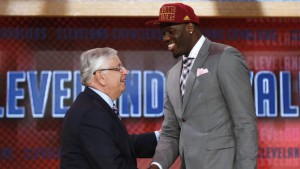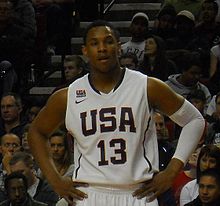With the midway point of the regular season approaching, we thought it would be a good idea to give the rookies a  break and rank the sophomores for two reasons.
break and rank the sophomores for two reasons.
1. It is a nice change of pace and gives the reader something new.
2. This rookie class is god-awful and we are running out of ways to describe how bad it is.
At the end of the season, NBA coaches are asked to vote for five players for an All-Rookie Team. We defy anyone who has watched this season to go five-deep into the rookie pool.
After Michael Carter-Williams, Victor Oladipo and Trey Burke, you can pretty much throw darts or play pin the tail on the donkey. There is a serious drop-off to a collection of players who have been nothing special in their debut seasons.
Last season was just the opposite. There were at least a dozen players who deserved All-Rookie consideration. Orlando’s Mo Harkless, who averaged 8.2 points and 4.4 rebounds, didn’t make either All-Rookie squad. This season, those numbers would rank him fifth and fourth among first-year players.
And this season, those rookies are now sophomores, some of whom are leaving an indelible mark on the league.
Among our top 10 sophomores are some obvious usual suspects. But perhaps the biggest surprise emergence has come from Boston Celtics big Jared Sullinger.
As a rookie, Sullinger showed flashes of what he could do at the NBA level. But with veterans Kevin Garnett, Brandon Bass and occasionally Jeff Green manning the big positions, Sullinger had trouble finding consistent minutes. And when he did, his rhythm often was derailed by foul trouble.
Sullinger bounced in and out of our Rookie Rankings until late January, when a back injury requiring surgery ended his season. His back woes were a red flag coming out of college and probably were the biggest reason he dropped from the low lottery to the 21st overall pick. Those who cautioned folks about Sullinger’s back issues probably felt somewhat validated.
In the offseason, however, Sullinger was getting healthy while the Celtics were cleaning house with a massive rebuilding project. All of a sudden, positions and minutes were available, and the big man has made the most of his opportunity.
As a starter, Sullinger has averaged 13.9 points, 8.6 rebounds and 2.0 assists. Yes, he is shooting just 42.5 percent from the field, a number you would hope to be a bit better from a big man.
But part of the reason Sullinger’s shooting has dropped is because he is adding a 3-pointer to his arsenal. Last season,  he was just 1-of-5 from 3-point range. This season, he is 27-of-96 (.281) from the arc and has nine games with at least two.
he was just 1-of-5 from 3-point range. This season, he is 27-of-96 (.281) from the arc and has nine games with at least two.
As Sullinger’s range expands, he is only going to become more dangerous as an offensive player. He hasn’t forgotten the best use of his 6-9, 260-pound girth, either, as Wednesday’s 25 points and 20 rebounds in a win over Toronto will attest.
It was the first 20-20 game by a Celtic since Nov. 2, 2007, when Garnett went for 22 and 20 in his first game in a Boston uniform. And Sullinger almost didn’t get there.
“I didn’t even think about it until (Rajon) Rondo said, ‘Look up at the scoreboard and get one more (rebound),'” he said. “To look up and see 19 rebounds, I didn’t know I had that many.”
The Celtics drafted Kelly Olynyk and signed Vitor Faverani in the offseason to deepen their frontcourt. But while Olynyk missed a chunk of time with a sprained ankle and Faverani fell out of the rotation, Sullinger emerged and is looking like part of the foundation in the rebuilding process.
Who said there’s a sophomore jinx?
On to the rankings.